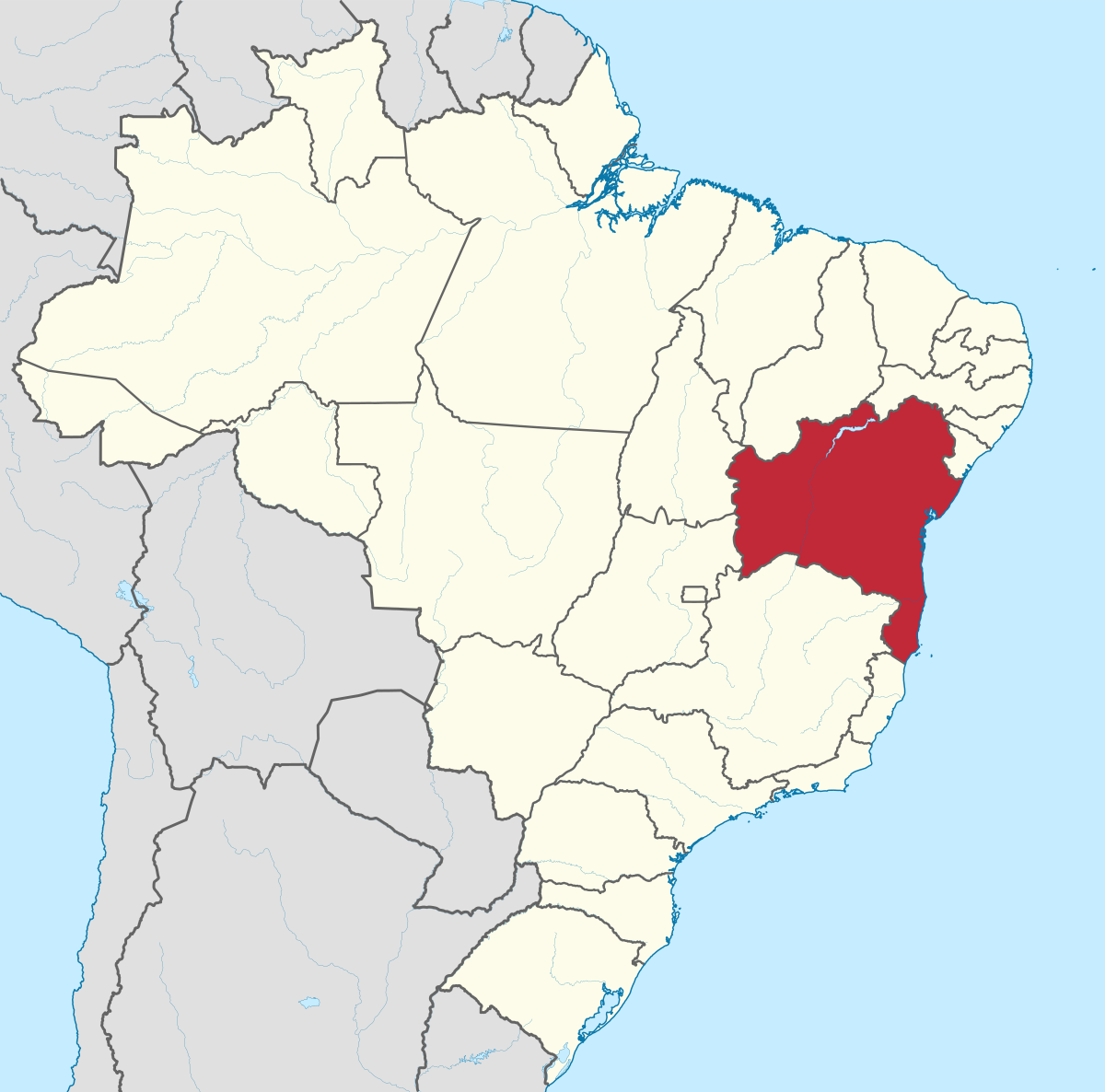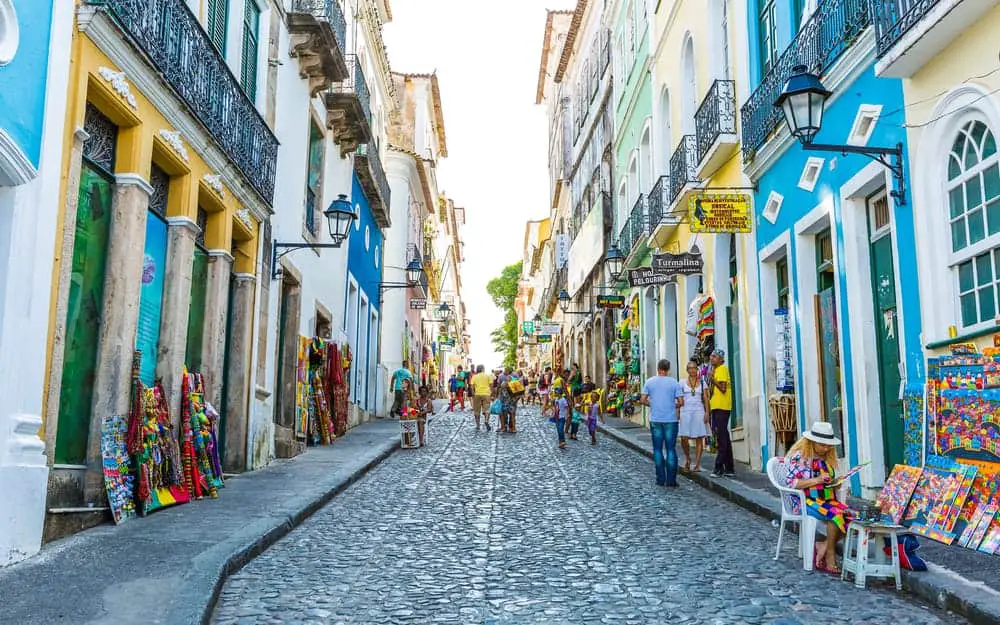Bahia
Bahia means "bay" and refers to the bay that European settlers stumbled upon in 1501. It is the fourth most populated state in Brazil and is located in the northeast. The capital city is São Salvador da Bahia de Todos os Santos or "Salvador". Bahia was a prime area for the Sugar plantations and industry. This booming industry lead to an influx of people including many African slaves.
Often referred to as "The Soul of Brazil. It is the epicenter of Afro-Brazilian culture and the birth place of Samba and Capoeira.
The population of Bahia is made up of a mixture of African and European lineage. Roman Catholicism is the primary religion. Crops grown in Bahia include sugarcane, cassava (manioc), soy, corn (maize), cotton, cacao (the source of cocoa beans), and sisal (Britannica, 2018).
It is made up of more than 50 small, yet stunning islands.
Para Você: Capoeira Video
First add the corn meal,
Then the African palm oil,
Look for a black woman from
Bahia – ô
That can - stir
That can - stir
That can - stir
Add cashew nuts
A little bit more
Red pepper
A little bit more
Add peanuts, shrimp and grate
the coconut
Then mix it all together
Finally, season it with salt,
ginger and onions, Yayá!
Often referred to as "The Soul of Brazil. It is the epicenter of Afro-Brazilian culture and the birth place of Samba and Capoeira.
The population of Bahia is made up of a mixture of African and European lineage. Roman Catholicism is the primary religion. Crops grown in Bahia include sugarcane, cassava (manioc), soy, corn (maize), cotton, cacao (the source of cocoa beans), and sisal (Britannica, 2018).
It is made up of more than 50 small, yet stunning islands.
What is Capoeira? Capoeira is a very symbolic Afro-Brazilian martial art developed by African slaves in Bahia Brazil. This martial art form is often confused for a dance as it involves rhythmical movements. These movements actually mimic those of apes as one has to try and stay as close to the ground as possible while also never taking their eyes off of their opponents. Slaves utilized this art form as a way to defend themselves from their masters. It is performed to the accompaniment of call-and-response choral singing and percussive instrumental music.
Para Você: Capoeira Video
What is Samba? A Brazilian dance of African origin from Bahia.
Food of Bahia
Vatapá:
If you want vatapá – ô
Try to make it like so:First add the corn meal,
Then the African palm oil,
Look for a black woman from
Bahia – ô
That can - stir
That can - stir
That can - stir
Add cashew nuts
A little bit more
Red pepper
A little bit more
Add peanuts, shrimp and grate
the coconut
Then mix it all together
Finally, season it with salt,
ginger and onions, Yayá!
Acarajé: Black-eyed-pea and shrimp fritters made from peeled beans formed into a ball and then deep-fried in dendê.
Bobo de Camarão: a chowder-like Brazilian dish of shrimp in a purée of manioc meal with coconut milk and other ingredients.
Architecture of Bahia
Montserrat Fort in Salvador is one of the best-known examples of Brazilian Military architecture. It is of Italian-inspired Design.
Church of Nosso Senhor do Bonfim, Bahia: This is one of the most famous churches in Brazil. One of its most iconic features is its painted wooden ceiling designed by Bahia artist Franco Velasco between 1818 and 1820.
São Joaquim Market - Largest Open Air Bazaar in Salvador, Brazil
Bahia has one of the largest Carnival celebrations in Brazil.
Music
Percussion
Brazilian Samba by Paloma Gomes
Paranaue - Capoeira










Bahia is so beautiful! I love the culture that is so apparent here.
ReplyDeleteCapoeira definitely looks like very graceful martial arts so I can see how it has been made into dances and performances as well. The church of Nosso Senhor do Bonfim amazes me. I would love to one day tie one of those bracelets on the wall and make a wish!
Bahia looks incredible! This is one of the states that has the most unique culture so far, in my opinion. There are a lot of beautifully unique parts about Bahia. My favorite feature was the bracelets of the saints, and I think that it's beautiful that people partake in tradition by wearing the bracelets until they wear down or fall off, or taking the bracelets to the church and making three wishes on each bracelet that they tie to the fence. I hope I can visit Bahia one day because I'd love to see and experience the Afro-Brazilian culture through art and music.
ReplyDeleteGreat job Jasmine! It was a very interesting presentation on an incredible place. I had heard of Capoeira before but was amazed at how difficult it appears. That Capoeira developed out of the peoples' needs to protect themselves speaks volumes about the regular brutality they endured. It is beautiful to watch but haunting too, knowing the history. The architecture and layout of the historical areas is beautiful and the food, particularly the Acaraje! I love all of the African influences that are so well-represented here and I think this might have been the most interesting destination so far!
ReplyDeleteI really enjoyed learning about Bahia! Brazil seems like it has soo many cultures and it is fascinating to see how they blend it and make a mixed culture. The pictures of the streets and buildings remind me a lot of a city in Mexico I love! It looks so pretty. The food sounds amazing and it looks like i would get full with a few bites. It is so cool that you know how to Capoeira!
ReplyDeleteI also enjoyed your presentation :) The food looks amazing! By far the Capoeira was the most fascinating to learn about in Bahia.
ReplyDeleteI also enjoyed learning about the wall of wishes. I think somewhere in Latin America they have the same tradition as well in which you tie a bracelet around you wrist and if it comes off your wish comes true.
I really enjoyed the presentation on Bahia. The woman in the video about Bahia was a bit strange though. Like all the other places, the food looks delicious! I also really like the architecture in Bahia, theres so many different influences from all over Europe and Africa.
ReplyDeleteI've watched friends practice the Capoeira dance, and it is a very fun, and interesting martial art. I've also seen that one of the worlds most powerful kicks is preformed using a technique belonging to Capoeira. The culture in Bahia is nice to see; a lot of the America is losing their culture, so it is nice to see special laces like this preserving it.
ReplyDelete